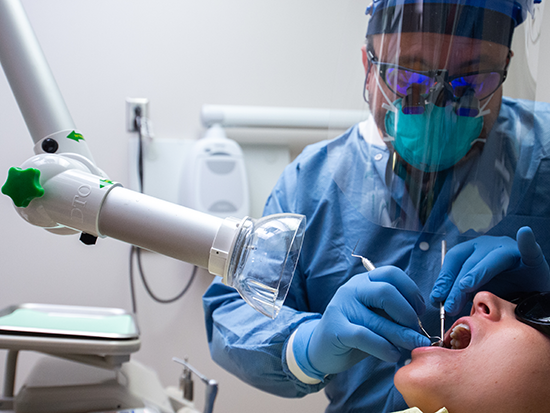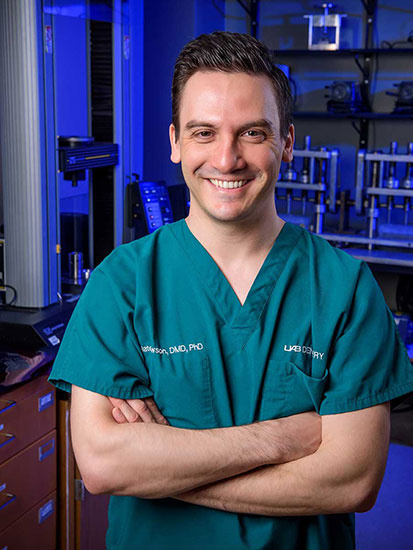Media Contact: Anna Jones
 Are you a daily flosser? Or have you been avoiding the dentist since the 20th century? Either way, here are some major dental innovations over the past decade.
Are you a daily flosser? Or have you been avoiding the dentist since the 20th century? Either way, here are some major dental innovations over the past decade.
Nate Lawson, DMD, Ph.D., associate professor at the University of Alabama at Birmingham School of Dentistry and director of the school’s Division of Biomaterials, shares how dental practices have significantly advanced over the years.
Cavities filled without the drill
Small cavities are manageable now without drilling away the tooth structure, thanks to resin infiltration, a technique to fill cavities at an early stage.
“This is one of the neatest things, which just has not made it into the public consciousness yet, for whatever reason,” Lawson said. “A clear resin is injected into the tooth and fills in the cavity in order to stop it from getting bigger.”
Resin infiltration is particularly effective at repairing what dentists call “white spot lesions” on the front teeth. These discolored spots, which are cavities, often appear after someone with braces has them removed.
“Resin infiltration can stop these from getting bigger and blends the lesions with the tooth for a great esthetic benefit,” Lawson said. “It is a great, conservative treatment. It doesn’t work all the time, but it works a good percentage of the time. And when patients find out about it, they love it.”
Bacteria-fighting fillings
New cavities are likely to form around fillings because they are not able to fight bacteria that surround them unless the patient changes their diet or brushing behavior. In response, dental manufacturers have created “bioactive” filling materials that release calcium, phosphate and fluoride ions, just as natural teeth do, preventing further cavities.
 Nate Lawson, DMD, Ph.D.“The number one reason that fillings fail is you get a new cavity around your existing filling,” Lawson said. “It is already a damaged tooth, and unless you change your brushing behavior and diet, you are more likely to have another cavity. When a tooth starts degrading, these new bioactive fillings can release minerals that prevent recurrent caries.”
Nate Lawson, DMD, Ph.D.“The number one reason that fillings fail is you get a new cavity around your existing filling,” Lawson said. “It is already a damaged tooth, and unless you change your brushing behavior and diet, you are more likely to have another cavity. When a tooth starts degrading, these new bioactive fillings can release minerals that prevent recurrent caries.”
Lawson and his team wanted to put this claim to the test. UAB is one of the few dental schools in the country with a dental materials-testing facility. In this facility, the team developed tests to evaluate bioactivity and found that there is some truth to the claims. Lawson warns, however, that they are not magic; people still must limit their exposure to sugar with their diet and remove plaque through brushing.
Digital dentistry
The traditional two-dimensional “bitewings” X-rays used for annual checkups have limitations, especially when they are being used to position dental implants. With 2D X-rays, dentists can figure out how close to the front and back of the mouth that implant should go, but not left and right. Dentists can now use cone beam CT machines to get 3D images that allow them to see exactly where that implant needs to go.
“Dental surgeons can now use a 3D printer to create a plastic guide for the tooth,” Lawson said. “Instead of a 2D X-ray, where the surgeon would say, ‘I think there’s enough space,’ but not know until pulling back the gum, now it is precise.”
3D images have significantly reduced the wait time to get an implant. Instead of waiting a week for an impression of a patient’s tooth to be milled into a crown at a specialty lab, a 3D scan and an in-office machine make the crown available in 30 to 45 minutes.
Applications for digital dentistry are numerous and growing, driven by speed and lower costs. The UAB School of Dentistry has specialized 3D mills and printers in its research area and clinics. In the school’s Orthodontics Clinic, for example, dentists scan a patient’s teeth and can design and produce a retainer on the spot.
